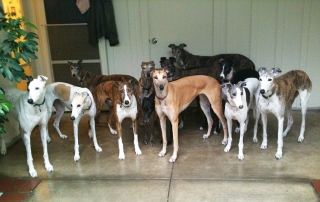Going Greyhound

While innocently surfing TV channels one Saturday afternoon in the early '90s, I came across an alarming undercover expose' on the plight of racing greyhounds. The dramatic footage showed emaciated dogs inside a dark trailer, standing up in crates stacked two-high with their heads held low, yearning eyes glowing from the light of the camera. Most of the dogs inside the pitch black trailer were still alive. Subsequent scenes featured audio of gunshots followed by dead hounds being tossed unceremoniously into a dumpster. Call it destiny, fate or divine intervention but that was it for me, time to get involved and Go Greyhound.
At the time, I had never met a retired racing greyhound up-close and in-person and didn't know the first thing about them or their intricacies. Now, nineteen years and five hounds later, here's a little bit of what I've learned about this remarkable semi-exotic creature.
At the track, they are treated more like livestock than dogs. Their entire world consists of their crate, the track and the turnout pen, where every other dog on the planet is a greyhound. They have a tremendous affinity for other greyhounds. They don't have any experience with things like windows, stairs, swimming pools, cars, other breeds of dogs or small humans. Once they leave the track environment everything is brand new to them and subject to interpretation. They are typically about 2 years old when retired, and by then while their clinical window of socialization has been closed for months (if not years) they are remarkably successful at acclimating to many kinds of situations.
On the plus side, retired racing greyhounds are already crate trained, learn household potty training quickly, tend not to dig or bark much and clean up easily in the shower! Watching them blossom into playful loving members of the family is mesmerizing and fulfilling. Their love for stuffed animals and soft places to lie is trumped only by their occasional need for speed, and good bowl of food.
The main thing I've learned about greyhounds as a professional dog trainer is that once you learn all of their special rules and needs and take all of their past experience and genetics into account, there's actually a dog in there, just waiting to emerge. As far as personalities go, they range from extroverted to introverted, goofy to reserved and everything else in between. No, they're not all shy, and yes there are some cat-friendly souls who never cared much for getting the lure at the track anyway. I currently have a very "biddable" dominant female, a laid-back "Pigs Fly"* (thank you Jane Killion) male and a new smarty-pants fresh-off-the-track boy... yet to be "categorized!"
As one of the oldest dog breeds, greyhound stories date back to ancient Egypt, Greece and Rome, where they were used for companionship and hunting. Physically they are optimized for speed, with lungs the size of a St. Bernard, amazingly long powerful legs and aerodynamic bodies. At full speed, their paws touch the ground only 25% of the time while they reach speeds up to 45mph. Their speed brings with it special considerations. Due to their innate prey aggression, greyhounds should never be allowed off leash in an unfenced area. They are sight hounds after all, and even something like a bag blowing down the street can catch their eye and launch their urge to chase it. Shut the front door! Doorways are like starting gates and families need to be extremely aware of that while working on impulse control exercises such as "wait" or "stay." Greyhounds have very thin skin and little fur, so they don't tolerate extremes of heat or cold and are considered inside dogs.
Clicker training is my technique of choice for greyhounds. It makes the shy more confident and the confident more manageable. Even my laid-back 9-year-old male will get up and dance around if he thinks it's time to "play clicker." (His favorite game continues to be "Fun with a Box!") The short duration of clicker training sessions is perfectly suited for greyhounds too, since they won't focus for long. As with everything else in their lives, they like it fast and fun! Any type of physical manipulation will cause them to completely shut down, so luring and shaping work great.
There are a few common greyhound myths that can be quickly dispelled with a little bit of knowledge and experience. For example, just because greyhounds are fast does not mean they're hyper. The phrase, "45 mph Couch Potato" wasn't coined for nothing. They tend to sleep nearly 20 hours a day and one 30 minute leash-held walk daily works just fine. Rescue groups adopt greyhounds out to people in small homes, condos and townhouses routinely too, since a large piece of property is not a requirement. Greyhounds can also be taught to sit, even though it's not a common position for them to offer naturally, and all five of mine learned "Sit" without a problem.
It's been a fantastic privilege to share my life with greyhounds and to show people how loving, special and addictive they truly are. Like rescue groups always say, ..."They're a lot like potato chips, you can't have just one!"
*When Pigs Fly! Training Success With Impossible Dogs, Jane Killion




